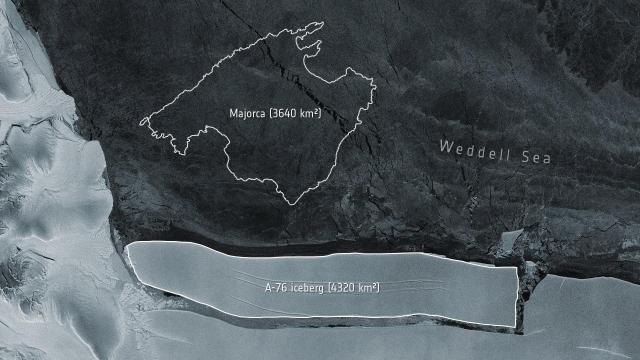There’s a new big ‘berg floating around Antarctica. The European Space Agency said Wednesday that a huge chunk of ice had broken off from the Ronne Ice Shelf into the Weddell Sea and formed the world’s largest iceberg.
When they say the world’s largest, they mean it — it’s got a 4,320 square kilometre surface area, and measures 175 kilometres long by 25 kilometres wide. It’s bigger than the Spanish island of Majorca, or if you prefer your measurements in American, bigger than the state of Rhode Island and around five times the size of New York City. ‘Berg big!
Scientists have dubbed the new arrival A-76 (catchy), using the convention of naming an iceberg after the Antarctic quadrant it was spotted in followed by a sequential number. The ESA first spotted A-76 in satellite images taken from the Copernicus Sentinel-1, and confirmed this week that it’s bigger than the current reigning ‘berg heavyweight champ, A-23A, which is also floating around the Weddell Sea after calving from the Filchner Ice Shelf all the way back in 1986. That ‘berg is only around 3,380 square kilometres — positively puny compared to the new guy in town.
Earlier this year, scientists documented a 788-square- kilometre glacier breaking off in dramatic fashion from the Brunt Ice Shelf. Impressive, sure. But it’s simply no match size-wise our new big boy. In 2017, an absolutely colossal piece of ice broke off from the Larsen C ice shelf. That iceberg, A-68, was the sixth-largest ever recorded at 5,800 square kilometres, bigger than the state of Delaware. While it splintered a bit after entering the open sea, it was still a force to contend with. At one point, scientists feared it could collide with ecologically sensitive South Georgia Island. But A-68A — the biggest of those splintered bits — quickly began disintegrating, and is now just a floating mess of ice. You hate to see an absolute king fall apart like that. But hey, at least A76 has come to pick up that big ‘berg crown.
Ice shelves birthing icebergs is mostly a pretty standard feature, not a bug. Some scientists studying the area and the ice shelves have said that these types of calving events would happen regardless of human influence and have scolded the media for sensationalising A68 and its tie to climate change. (Though to be fair, a state-sized hunk of floating ice is pretty sensational.) But research has shown that rising temperatures have taken their toll on other ice shelves that jettisoned large icebergs and collapsed shortly thereafter.
There are other clear signs that Antarctica is being impacted by climate change. West Antarctic ice shelves are facing a warm water invasion that could tip them into a state of unstoppable collapse if the world heats up much further. In fact, numerous ice shelves and glaciers that ring Antarctica are in decline. Since 1992 alone, the continent has shed 3 trillion tons of ice, and the rate of loss is speeding up. Things are a lot less stable in Antarctica since the world started pumping carbon dioxide into the atmosphere with abandon, and scientists are keeping an eye on the continent’s ice shelves as the earth continues to warm.
